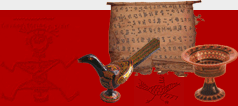|
论彝族毕摩及医药文化
Yi Bimo and Medical Culture
何定安He Dingan (曲木约质)
云南社会科学院楚雄彝族文化研究所
【摘要】彝族毕摩是彝族祭师,是宗教祭祀的主持者,是彝族古代社会的知识分子。毕摩必须精通彝族宗教祭祀的全部内容,既会念经,熟悉道场(祭场)设置,了解宗教仪式及程序并能独立主持宗教活动,为人驱鬼祈神治病。他必须掌握彝文经典并加以应用,了解彝族历史文化,掌握历算、天文、地理、医药、文学及神话传说、哲学、宗教等等知识。毕摩一般是祖传,由男人担任,需经过与师傅学习多年,并在祭祀活动中担任学徒“毕惹”多年,掌握相关知识,才能担任。彝族医药文化具有其特色,医疗观念古朴、医药实践丰富。彝文古籍中已记录了医药方剂等。彝族的医药保健、食品禁忌等也有其独特的内容。彝族药已有多种药剂开发应用。彝族医疗方法有土洞蒸疗法、草莲帘(席)蒸疗法;有穴位针(獐牙香针)刺激法;有火攻穴位刺激、穴位艾火疗法;有打咂角拔火罐疗法;有火油拔毒治疮疗法等。彝族毕摩在医疗文化中起重要作用,医疗观念中,认为病由不洁物(细菌)及灵魂不洁而引起,毕摩则医治人的灵魂和肉体,毕摩有《献药经》、《驱邪经》等等,毕摩在行祭祀时,也用医疗及药物手段等。
关键词:彝族 毕摩 医药文化
Abstract
Bimo, the ritualist of Yi ethnic group, takes the responsibilities
for hosting religious rituals, and is the most educated
group in traditional Yi society. Bimo has to be well up
in the whole content of Yi religious rituals, able to reciting
the texts as well as supervising the setup of the place
of rituals. He also needs to know well of religious rituals,
the process and hosting ritual activities independently,
and be familiar with exorcism, praying and healing. Bimo
must master various Yi scriptures and make use out of them,
at the same time, knowing Yi history, calendar-counting,
astronomy, geography, medication, literature and folklore,
philosophy and religion is also a necessity. The position
of Bimo is usually handed down from generation to generation,
and possessed solely by men. To be a Bimo, the men need
to learn for many years from their masters and perform as
“Bisse” (apprentice of bimo) in those ceremonies several
times in order to master the know-how. The Yi medical culture
is quite characterized with simple concepts and rich experience.
Medical prescriptions are recorded in the ancient books
in Yi language. It is also specialized in health protection
and food taboo. A certain number of Yi medical treatments
have been developed and put into use. To name a few, steam
baths in an underground cave, steam baths wrapped in a glass
mat, acupuncture on body-points, moxibustion on body-points,
fire-jar suction, and oil for tumefaction, etc. Bimo plays
a very important role in the medical culture of Yi ethnic
group, in which there is the concept that diseases are caused
by unclean objects or unclean soul, therefore, it is Bimo’s
job to cure both men’s body and soul. Bimo will use “Xian
yao jing” and “Qu xie jing” in the ceremonies, during which
he also uses medical treatment and medications.
Keywords: Yi ethnic group─bimo─folk medicine
作者简介:
何定安(曲木约质),22年师从中国社会科学院民族学与人类学研究所刘尧汉教授,从事彝族历史文化研究工作。同时,向凉山土司岭光电、祭师(毕摩)曲比作哈、学者严汝娴、余宏模等学习民族学及彝文化。曾与意大利学者白琳、美国学者刘小幸等合作研究彝文化。在川、滇、黔彝区从事实地调查近十年。写出彝学专著及论文总计近百万字发表。主要代表作有:《凉山白彝曲木氏族世家》(专著)、《凉山彝族习惯法案例集成》、《大梁山主峰小的祭祀——阿候氏族祭祖大典》等专著。另有论文《凉山彝族宗教祭祀综述》、《彝族毕摩文化》等论文近六十篇。相关学术成果引起中外专家的重视。
About the author:
He Ding’an (Qomo Yorryr) has been learning from Prof.
Liu Yaohan at the Institute of Ethnology and Anthropology,
Chinese Academy of Social Sciences, and studying the history
and culture of Yi ethnic group for 22 years. During the
same time, he also learned Yi culture from Tusi Leng Guangdian
in Liangshan, Bimo Qubi Zuoha, Han Chinese scholar Yan Ruxian,
and Yi scholar Yu Hongmo, co-studied with Italian scholar
Bai Lin, and American scholar Liu Xiaoxing, investigated
in Yi areas in Sichuan Province, Yunnan Province and Guizhou
Province. He has published essays and works on Yi culture
of all-together millions of words. The major ones are: “liang
shan bai yi qu mu shizu shijia”, “liangshan yizu xiguanfa
anli jicheng”, “daliangshan zhufeng xiao de jisi—ahou shijia
jizu dadian” and so on. Besides, he has nearly 60 articles
including: “liangshan yizu zongjiao jisi zhongsu”, “yizu
bimo wenhua”, etc. His scholarly writings draw attention
from experts both home and abroad.
|





